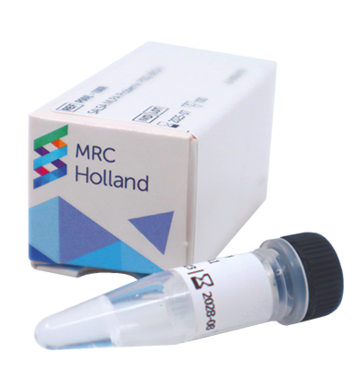Charcot-Marie-Tooth disease (CMT), with an average prevalence of 14.5 per 100 000, varying from 9.7 per 100 000 to 82.3 per 100 000, is the most common hereditary sensorimotor neuropathy, comprising a group of clinically and genetically heterogeneous peripheral neuropathies. CMT is characterized by progressive distal muscle atrophy and weakness, sensory disturbance, the absence of deep tendon reflexes, and pes cavus deformity of the foot. More than 80 different genes are associated with CMT (http://www.ncbi.nlm.nih.gov/books/NBK1358/). Subtypes related to the genes PMP22, GJB1, MPZ and MFN2 are the most common ones, being responsible for up to 95% of CMT cases with a final diagnosis (Padilha et al. 2020). The disease can be inherited in an autosomal dominant, autosomal recessive or X-linked manner. Table 1 provides an overview of the different genes involved in the CMT subtypes and the probemixes that cover these genes.
The most frequent form, CMT1A, accounts for as much as 50% of all CMT cases. CMT1A is a dominantly inherited, childhood-onset, slowly progressive motor and sensory neuropathy due to a duplication of PMP22 on chromosome 17. CMT1B accounts for an additional ~10% of CMT1 patients. The gene involved in CMT1B is myelin protein zero (MPZ). CMT1A and 1B are clinically indistinguishable; classification is based solely on molecular findings.
X-linked CMT (CMTX) is characterized by moderate to severe motor and sensory neuropathy in affected males and usually mild to no symptoms in carrier females. Subtype CMT1X accounts for about 90% of X-linked CMT, and is caused by mutations in the gap-junction protein beta 1 (GJB1) gene (https://www.ncbi.nlm.nih.gov/books/NBK1374/).
Hereditary neuropathy with liability to pressure palsies (HNPP) is characterized by repeated focal pressure neuropathies such as carpal tunnel syndrome and peroneal palsy with foot drop. Recovery from acute neuropathy is often complete; when recovery is not complete, the resulting disability is usually mild. Some affected individuals also have signs of a mild to moderate peripheral neuropathy. The prevalence of HNPP is estimated at 1 per 50,000 to 1 per 20,000. The penetrance is 100% but expressivity is highly variable even within the same family. Approximately 6-23% of individuals diagnosed with HNPP have an asymptomatic affected parent. A contiguous gene deletion of chromosome 17p12 that includes PMP22 is present in approximately 80% of affected individuals; the remaining 20% have a pathogenic variant in PMP22 (https://www.ncbi.nlm.nih.gov/books/NBK1392/).
Table 1. Overview of the probemixes and genes related to CMT.
| Probemix* |
Genes and coverage |
Condition |
Remarks |
| P033-B4 CMT1 (IVD) |
PMP22: all exons
KIF1b: 2 probes
|
CMT1A and HNPP
CMT2A1
|
PMP22 probes in P033-B4 have the same ligation site as PMP22 probes in P405-B1 except for one exon 1 probe and one exon 4 probe. There is one additional PMP22 exon 5 probe present in P033-B4.
|
| P405-B1 CMT1 (IVD) |
PMP22: all exons
MPZ: all exons
GJB1: all exons
|
CMT1A and HNPP
CMT1B
CMTX
|
PMP22 probes in P405-B1 have the same ligation sites as PMP22 probes in P033-B4 except for one exon 1 probe and one exon 4 probe. There is one additional PMP22 exon 5 probe present in P033-B4.
MPZ probes in P405-B1 have the same ligation sites as MPZ probes in P143-C3.
|
| P143-C3 MFN2-MPZ (RUO) |
MFN2: all exons
MPZ: all exons
|
CMT2A
CMT1B
|
MPZ probes in P143-C3 have the same ligation sites as MPZ probes in P405-B1.
|
* IVD: in vitro diagnostic. RUO: research use only.
Several types and subtypes of Charcot-Marie-Tooth disease exist, each involving a different gene or locus. Furthermore, there is a large overlap in clinical phenotype between the different types of CMT. Other disorders with comparable clinical features have been described, including hereditary neuralgic amyotrophy (HNA), amyloid neuropathies, Krabbe disease and hereditary ataxias. Therefore, molecular diagnosis may be complicated for certain patients.





